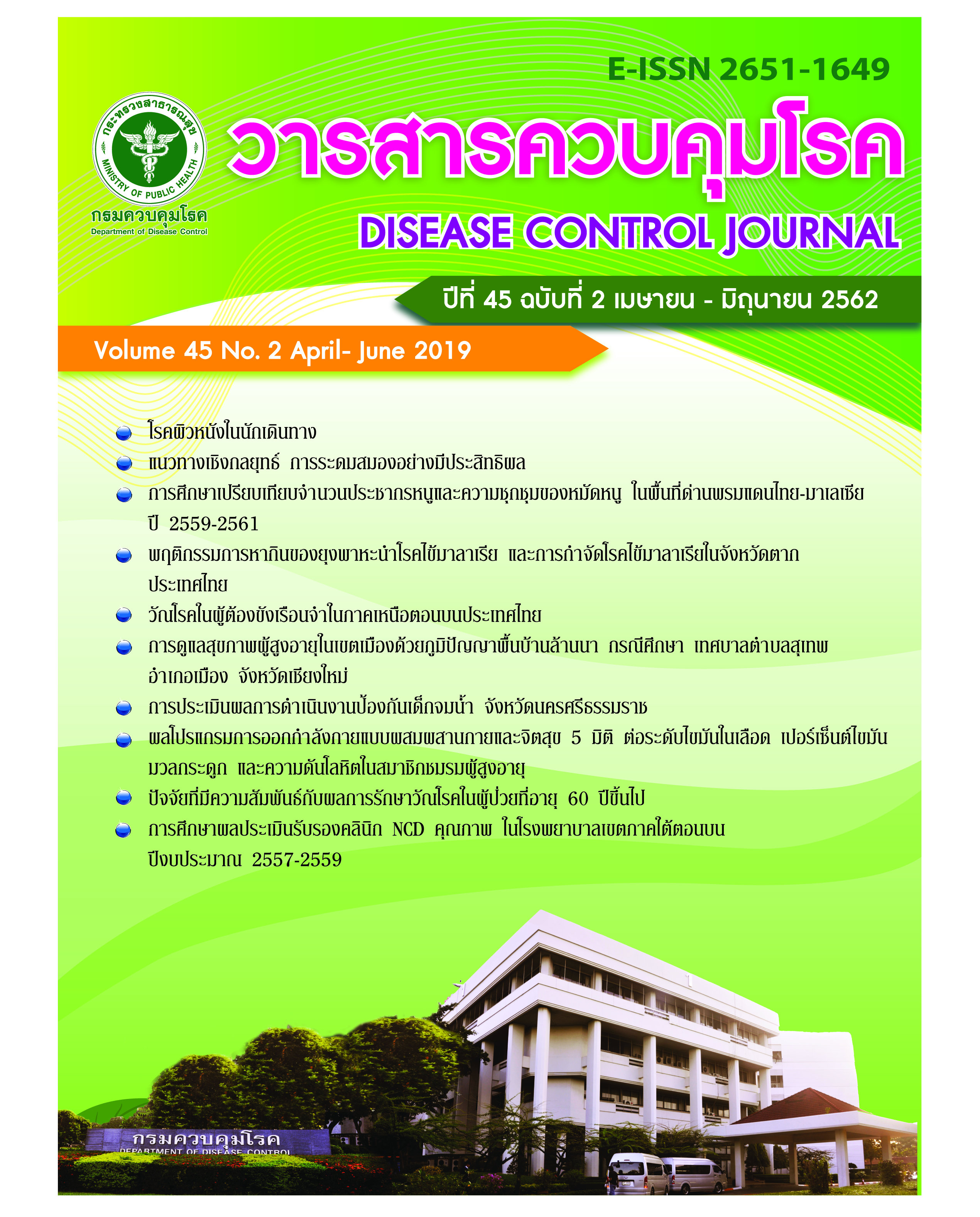Situations, characteristics, and relative risk factors of TB cases in prisons in the upper north of Thailand
DOI:
https://doi.org/10.14456/dcj.2019.5Keywords:
tuberculosis, prisonAbstract
Tuberculosis (TB) remains a public health problem for Thailand. The number of reported TB cases among prisoners in Thailand’s upper north has increased over the past 10 years. An important barrier to TB treatment success in prisoners was a frequent relocation of prisoners to other detention facilities during treatment period. This is a retrospective cohort study aimed to find the association between risk factors and death among TB-affected prisoners. Treatment outcomes were retrieved from TB case management database (TBCM online), which is the single recommended electronic TB recording in hospitals throughout Thailand. The study identified a total of 557 TB cases in prisons. Of these, 59 cases (10.6%) died while on treatment. Average time from start of treatment to death was 51.19 days. The risk factors associated with death were male (RR 1.3, 95% CI 0.03-4.9, p>0.05), age 61-65 yrs. (RR = 3.00; 95% CI = 0.39–23.07), age 66-70 yrs. (RR = 2.25; 95% CI = 0.30–16.63), age > 70 yrs. (RR = 2.00; 95% CI = 0.24–16.61), lung cavity (RR1.2, 95% CI 0.6-2.3, p>0.05), Human Immunodeficiency Virus positive (RR 3.6, 95% CI 2.2-6.0, p<0.05), and no administration of anti-retroviral drugs among HIV-infected cases (RR 4.0, CI 2.0-8.0, p<0.05). Mean body weight of fatal TB cases was 49 kg and in those who remained alive was 53 kg (p<0.05). It was concluded that major risk factors associated with death among TB-affected prisoners were age >60 years, co-infection with HIV, no initiation of anti-retroviral therapy, and body weight less than 50 kg. Early case detection revealed a reduction in disease severity and timely initiation of treatment could also reduce the death rates. In those with co-infection with HIV, early treatment with ART also reduced the mortality rates.
Downloads
References
2. Maher D, Grzemska M, Coninx R, Reyes H. Guidelines for the control of tuberculosis in prisons. Geneva: World Health Organization; 1998.
3. Bureau of Tuberculosis. TBCM dashboard [Internet]. [cited 2019 Jan 22]. Available from: https://www.tbthailand.org (in Thai).
4. Nachega JB, Maartens G. Clinical aspects of tuberculosis in HIV-infection adults. In: Schaaf HS, Zumla A, editors. Tuberculosis e-book: a comprehensive clinical reference. Philadelphia: Saunders Elsevier; p 524-31.
5. Kwan CK, Ernst JD. HIV and tuberculosis: a deadly human syndemic. Clin Microbiol Rev 2011;24:351-76.
6. Yazdani-Charati J, Rezai MS, Fendereski A, Mohammadi S, Alipour N. Treatment delay and total delay among pulmonary tuberculosis patients in the North of Iran: application survival data analysis. Tanaffos 2017;16:13-21.
7. Dara M, Acosta CD, Melchers NV, Al-Darraji HA, Chorgoliani D, Reyes H, et al. Tuberculosis control in prisons: current situation and research gaps. Int J Infect Dis 2015;32:111-7.
8. Singhal S, Jaiswa P. Presentation of tuberculosis in TB-HIV co-infection patients and the treatment outcome with directly observed short course therapy. Asian Pac J Trop Biomed 2011;1:S266-7.
9. Moolphate S, Aung MN, Nampaisan O, Nedsuwan S, Kantipong P, Suriyon N, et al. Time of highest tuberculosis death risk and associated factors: an observation of 12 years in Northern Thailand. Int J Gen Med 2011;4:181-90.
10. Jonnalagada S, Harries AD, Zachariah R, Satyanarayana S, Tetali S, Chander GK, et al. The timing of death in patients with tuberculosis who die during anti-tuberculosis treatment in Andhra Pradesh, South India. BMC Public Health 2011;11:921.
11. Manosuthi W, Chottanapand S, Thongyen S, Chaovavanich A, Sungkanuparph S. Survival rate and risk factors of mortality among HIV/tuberculosis-coinfected patients with and without antiretroviral therapy. J Acquir Immune Defic Syndr 2006;43:42-6.
12. Murray CJ, Ortblad KF, Guinovart C, Lim SS, Wolock TM, Roberts DA, et al. Global, regional, and national incidence and mortality for HIV, tuberculosis, and malaria during 1990–2013: a systematic analysis for the Global Burden of Disease Study 2013. Lancet 2014;384:1005-70.
13. Biruk M, Yimam B, Abrha H, Biruk S, Amdie FZ. Treatment outcomes of tuberculosis and associated factors in an Ethiopian University Hospital. Advances in Public Health 2016;2016: 1-9.
14. World Health Organization. Guideline: nutritional care and support for patients with tuberculosis. Geneva: World Health Organization; 2013.
15. Bhargava A, Bharti K, Anura K, Bhargava M, Rao R, Parmar M, et al. Guidance document: nutritional care and support for patients with Tuberculosis in India 2017. New Delhi: World Health Organization; 2017.
16. Ministry of Public Health. National tuberculosis control program guideline, Thailand 2018. Bangkok; Bureau of Tuberculosis, Bureau of Tuberculosis, Department of Disease Control. (in Thai)
17. Swai HF, Mugusi FM, Mbwambo JK. Sputum smear negative pulmonary tuberculosis: sensitivity and specificity of diagnostic algorithm. BMC Res Notes 2011;4:475.
18. Thonsiri W. Sensitivity and specificity of sputum AFB smear test of out-patient laboratory, Prapokklao Hospital, Chantaburi. J Prapokklao Hosp Clin Med Educat Center 2016;33:110-7. (in Thai)
19. TB CARE I. International Standards for Tuberculosis Care. 3rd ed. TB CARE I: The Hague; 2014.
20. Somrit N. Performance and readiness of village health volunteers on supervision of tuberculosis patients by directly observed treatment short-course, Kokha District, Lampang Province [dissertation]. Bangkok: Thammasat University; 2015. 65 p. (in Thai)
21. Fuge TG. Ayanto SY. Prevalence of smear positive pulmonary tuberculosis and associated risk factors among prisoners in Hadiya Zone prison, Southern Ethiopia. BMC Res Notes 2016;9:201.
22. Pluaysri M, Tipwareerom W, Hingkanont P, Prachanban P. The factor affecting self-care capabilities of prisoners with tuberculosis in the Lower Northern Region Prisons. Journal of Nursing and Health Sciences 2015;9:45-56. (in Thai)
23. Moller L, Gatherer A, Dara M. Barriers to implementation of effective tuberculosis control in prisons. Public Health 2009;123:419-21.
24. Adane K, Spigt M, Johanna L, Noortje D, Abera SF, Dinant G-J. Tuberculosis knowledge, attitudes, and practices among Northern Ethiopian prisoners: implications for TB control efforts. PloS One. 2017;12:e0174692.
Downloads
Published
How to Cite
Issue
Section
License
Articles published in the Disease Control Journal are considered as academic work, research or analysis of the personal opinion of the authors, not the opinion of the Thailand Department of Disease Control or editorial team. The authors must be responsible for their articles.






